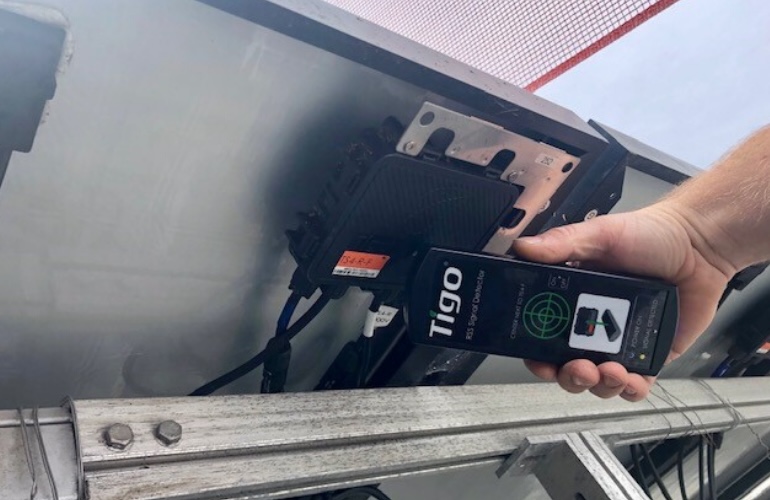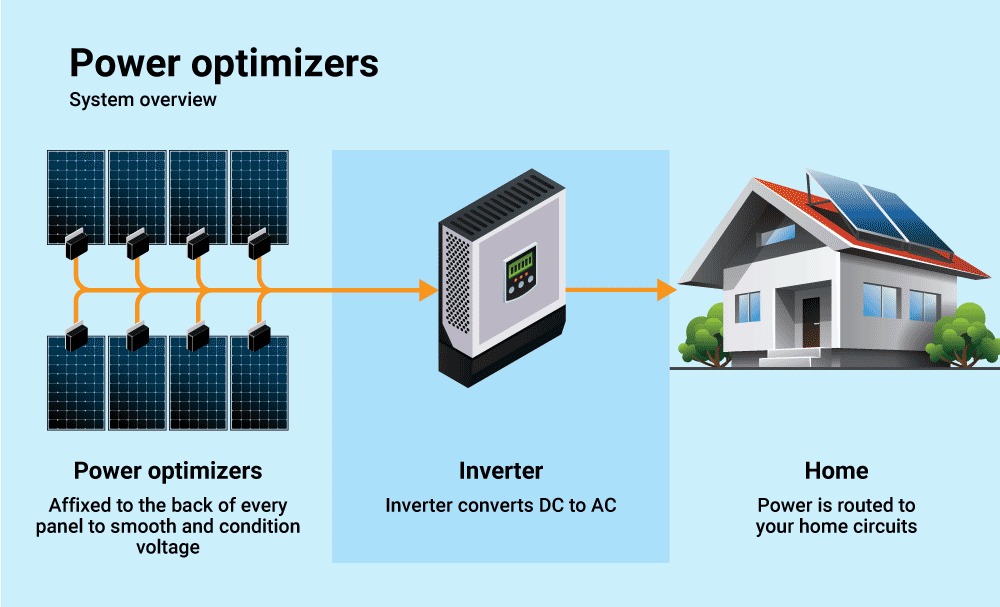Last update May 28th, 2024 at 10:48 am
By now you have probably come across the term solar optimisers. If you have invested in a solar panel system, it might be frustrating to experience a low system output due to partial shading. Solar panels that get shade from trees or similar will affect your whole solar system if you don’t have microinverters.
Luckily, there is a more affordable alternative on the market: The solar optimiser. Here we will explain everything you need to know about this smart device!

What is a solar optimiser?
Solar optimisers or DC optimisers are devices designed to maximise the solar energy output from a photovoltaic system with a string inverter.
The device attaches to one or more solar panels and will allow it (or them) to work independently from the rest of the panels.
If the sunlight does not reach a solar panel, the panel(s) with a DC optimiser will not be affected.

Are solar optimisers the same as microinverters?
No. A solar inverter is the unit that converts direct current (DC) to alternating current (AC) used by the appliances in your home. Most Australians have a single-string inverter connected to all the solar panels.
If one of your solar panels gets shade, it will produce less (or no) electricity. With a string inverter, the other solar panels will stop working. Even when they are exposed to the sun.
Alternatively, you can have microinverters, which means that each single solar panel has its own inverter. This allows the solar panels to work independently. In other words, the solar optimiser will deliver a similar function to your solar system as the micro inverters.
However, solar optimisers operate with string inverters. For many Australians, microinverters are too expensive. The solar optimiser can be a good alternative, as it is cheaper.
How does a power optimiser work?
A solar optimiser is working by using Maximum Power Point Tracking (MPPT) technology to improve the performance of every single solar panel. The DC optimiser fits on the underside of the panel making the panel a smart module.
The solar optimiser will track the power output peak of the panel. Then it will regulate the solar voltage and transfer the electricity to your inverter.
Benefits of having DC optimisers
If you have DC or solar optimisers, this might be beneficial in many ways. First of all, the device will be able to resolve problems related to shading from trees or buildings. Secondly, it can fit on certain panels (not necessarily all), which gives you flexibility.
For Australians interested in upgrading their solar system, solar optimisers can be a very effective solution.
Another benefit of solar optimisers is the fact that they are suitable for multi-orientation installations, as they can suit multiple orientations.
If you have solar panels that are facing in multiple directions because of a complicated roof structure, a solar optimiser will ensure that each solar panel can work as efficiently as possible when exposed to sunlight.
Are solar optimisers safe to use?
Yes. The solar optimisers found on the Australian market come with a safety voltage function. This ensures that the direct current voltage reduces automatically in case of faults or shutdowns.
For example, if your solar inverter or grid power shuts down, the DC voltage re-sets to a safe level. This will also happen in case of a disconnection between the module and optimiser if a safety switch turns off or if a system error occurs.
What do solar optimisers cost?
Solar optimisers usually come as an add-on to the solar panel system and as an additional cost to the rest of the system. In Australia, DC optimisers usually cost somewhere between $1.500 and $2.000 on top of the cost of a standard 6.6 kW solar panel system.
In comparison, microinverters for a 6.6 kW system will cost around $7,000, or $1,150 per kW of the system.
Is it worth investing in solar optimisers?
Yes, solar optimisers are usually a very good investment for both residential and commercial use. It is a worthy investment, especially for Australians who experience shading of one or more solar panels throughout the day.
DC optimisers can also be a great investment for anyone who would like to increase the solar system efficiency.
Power optimisers come at a significant cost and the rebate scheme doesn’t cover this extra cost. But if you have the money, a solar optimiser can absolutely be a great investment.
Do you want to learn more about solar optimisers? Contact a solar installer today, and start planning the improvement of your solar panel system.